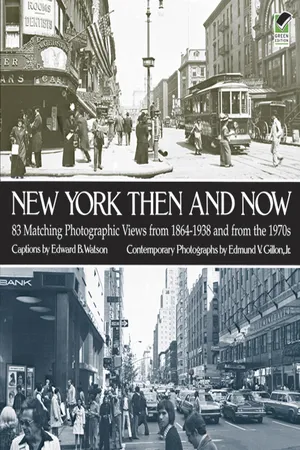
- 171 pages
- English
- ePUB (mobile friendly)
- Available on iOS & Android
eBook - ePub
New York Then and Now
About this book
Watch New York change before your eyes: 83 early Manhattan sites are set against 83 modern photos taken from same position: Times Square, Wall Street, Fifth Avenue, many more. Early photographs from 1875 to 1925 contrasted with 1976.
Frequently asked questions
Yes, you can cancel anytime from the Subscription tab in your account settings on the Perlego website. Your subscription will stay active until the end of your current billing period. Learn how to cancel your subscription.
No, books cannot be downloaded as external files, such as PDFs, for use outside of Perlego. However, you can download books within the Perlego app for offline reading on mobile or tablet. Learn more here.
Perlego offers two plans: Essential and Complete
- Essential is ideal for learners and professionals who enjoy exploring a wide range of subjects. Access the Essential Library with 800,000+ trusted titles and best-sellers across business, personal growth, and the humanities. Includes unlimited reading time and Standard Read Aloud voice.
- Complete: Perfect for advanced learners and researchers needing full, unrestricted access. Unlock 1.4M+ books across hundreds of subjects, including academic and specialized titles. The Complete Plan also includes advanced features like Premium Read Aloud and Research Assistant.
We are an online textbook subscription service, where you can get access to an entire online library for less than the price of a single book per month. With over 1 million books across 1000+ topics, we’ve got you covered! Learn more here.
Look out for the read-aloud symbol on your next book to see if you can listen to it. The read-aloud tool reads text aloud for you, highlighting the text as it is being read. You can pause it, speed it up and slow it down. Learn more here.
Yes! You can use the Perlego app on both iOS or Android devices to read anytime, anywhere — even offline. Perfect for commutes or when you’re on the go.
Please note we cannot support devices running on iOS 13 and Android 7 or earlier. Learn more about using the app.
Please note we cannot support devices running on iOS 13 and Android 7 or earlier. Learn more about using the app.
Yes, you can access New York Then and Now by Edward B. Watson,Edmund V. Gillon, Edmund V. Gillon in PDF and/or ePUB format, as well as other popular books in History & North American History. We have over one million books available in our catalogue for you to explore.
Information
NEW YORK THEN AND NOW
83 MATCHING PHOTOGRAPHIC VIEWS FROM 1864–1938 AND FROM THE 1970s

Broadway, North from State Street, Looking toward Bowling Green (1914)
Here is the beginning of Broadway, New York’s greatest street. The edge of the Customs House (right) shows Daniel Chester French’s allegorical group Africa, one of the Four Continents group. The Washington Building is located on the left-hand corner; the Bowling Green Building is just beyond. Behind the only double-deck streetcar ever to run in New York City is the great canyon of lower Broadway. The steel construction with finished courses of white brick, visible at left center, is the Adams Express Building. Farther along on the west side of Broadway stands the tower of the Singer Building. In the distance is the recently completed Woolworth Building, then the world’s tallest structure.
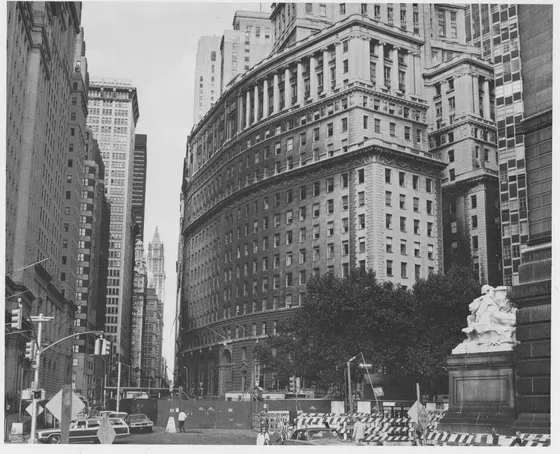
Broadway, North from State Street, Looking toward Bowling Green (1974)
In late 1974, Bowling Green, New York’s first public park, was being reconstructed to conform with the plan of 1786. The former Customs House, with the sculptured group Africa, stands unchanged and the Bowling Green Building remains at the extreme left. Beyond Bowling Green, on the east side of Broadway, is the huge No. 26 Broadway Building, originally built for the Standard Oil Co. in 1924. It took the place of the three office buildings on the site. Looking up Broadway, the former Adams Express Building (now American Express), with a dark cornice, still remains. The Singer Tower is gone, but in its place is the new United States Steel Building, the top of its black structure visible to the right of the American Express Building. In the center, the Woolworth Tower continues to dominate lower Broadway. (9/30/74; 3:15.)
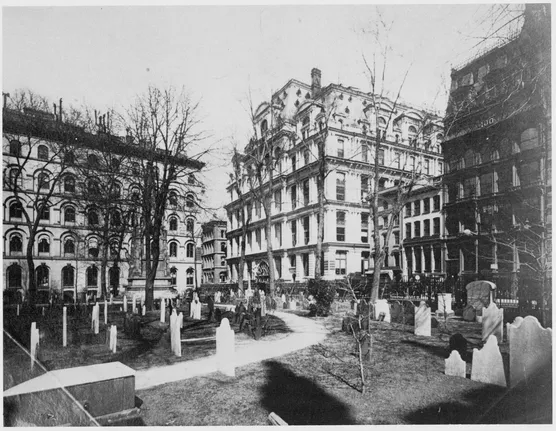
Trinity Churchyard, Looking North to Broadway and Pine Street (1890)
This view of part of the north section of the Trinity Church graveyard shows a number of aged gravestones, some dating from the last half of the seventeenth century. Many well-known New Yorkers were buried here, among them Alexander Hamilton and Robert Fulton. Even though this graveyard is located in the midst of the busy downtown financial district, it offers a sense of repose and quiet. All the various office buildings shown here have been demolished during the past fifty years. The large structure in the center is the headquarters of the Equitable Life Assurance Society, occupying a full acre of ground from Broadway to Nassau Street and from Pine to Cedar Streets. The building was destroyed by fire on January 9, 1912. The building on the left is the six-story Trinity Building, designed in 1852 by the famous architect Richard Upjohn, who designed the present Trinity Church.
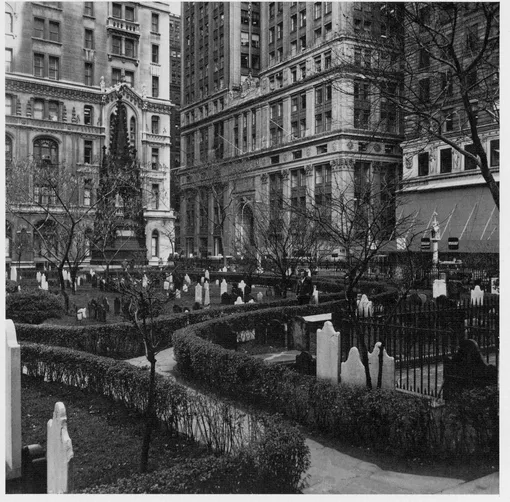
Trinity Churchyard, Looking North to Broadway and Pine Street (1974)
There has been very little change in the churchyard. Some low hedges and railings have been added as protection. The large brownstone monument with the small steeple (hidden by a tree in the 1890 photo) is the Martyrs’ Memorial, erected in 1858 in memory of the soldiers of the American Revolution who died in prison during the British occupation of New York (1776-83). The building on the right, undergoing first-floor renovation, is the 22-story American Surety Co., built in 1894 and greatly enlarged in 1920. The building in the center is the 38-story Equitable Life Building, built in 1913-15 on the site of the firm’s older building. It was the world’s largest office building from 1915 until 1931. On the left is the 21-story second Trinity Building, erected in 1904 on the site of the original Trinity Building. (12/3/74; 12:40.)

Park Row, Looking Southwest toward Broadway (1892)
The beginning of Park Row at Broadway, with suitable loop and storage tracks, was a busy terminal for horsecar lines. The six-story granite building on the right, at the northwest corner of Broadway and Vesey Street, is the Astor House, the leading downtown hotel. Originally called the Park Hotel and designed by Isaiah Rogers, it was built in 1832-36 on the site of the residence of John Jacob Astor, who also owned the hotel. It was favored by celebrities until the imposing Fifth Avenue Hotel was opened in 1858 at Fifth Avenue and 23rd Street. The Astor House’s rotunda lunchroom was the most popular eating place in downtown New York. St. Paul’s Chapel (Thomas MacBean, architect) is the oldest church and public building in New York. It was erected on Broadway, between Vesey and Fulton Streets, in 1764-66 as a chapel of Trinity Church. The portico was added in 1768. The clock tower with steeple, modeled on James Gibbs’s St. Martin’sin-the-Fields, London, was built in 1794. The front of the chapel was designed to face the fine view of the Hudson River. The stone chapel is famous not only for its architecture and antiquity but also for the pew, still preserved, that George Washington occupied while he was in New York. The L-shaped structure beyond the chapel is the Mail and Express Building, designed by Henry J. Hardenbergh and built in 1891.

Park Row, Looking Southwest toward Broadway (1974)
Park Row is used as a turning loop for several important New York City bus lines. In 1914 the south half of the Astor House was demolished to make way for the Astor House Office Building, now the Franklin Society Federal Savings & Loan headquarters (Charles A. Platt, architect). The north half of the Astor House came down in 1927, and York & Sawyer’s 43-story Transportation Building, part of which is visible at the right, was built on the site. St. Paul’s Chapel, although hemmed in by numerous tall buildings, remains New York’s outstanding landmark and an architectural gem. At the left, on the Fulton Street side of St. Paul’s, is the American Telephone & Telegraph Building, designed by W. W. Bosworth, which took the place of the Mail and Express Building in 1922. The two huge 110-story World Trade Center towers rise in the background. Recently completed, they were for a short time the tallest buildings in the world, until Chicago’s Sears Tower claimed the title in 1973. (12/3/74; 12:35.)
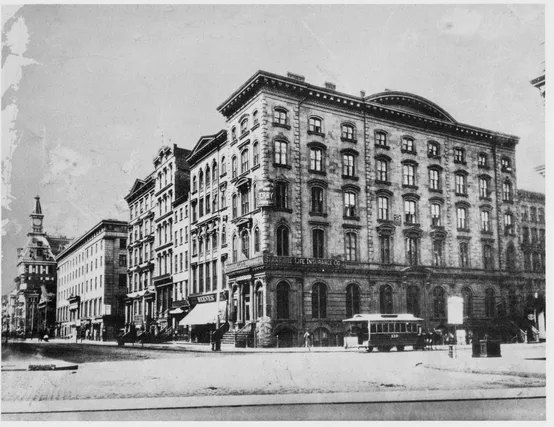
West Side of Broadway, South from Park Place (1880)
It must have been early on a quiet Sunday morning that this photo was taken; there are few pedestrians and the only traffic is a horsecar of the Broadway and Seventh Avenue line, waiting on Park Place to start its uptown run to 59th Street. The five-story Berkshire Life Insurance Building on the corner was built in 1852, the year after the founding of the Broadway Savings Bank, which occupied the first-floor rear section for 55 years. In 1885 two additional stories were added to the building. One block south stands the famous Astor House and directly beyond is the portico of St. Paul’s Chapel. The tall structure farther along is the Western Union Telegraph Building, one of the tallest buildings in New York when erected in 1873.
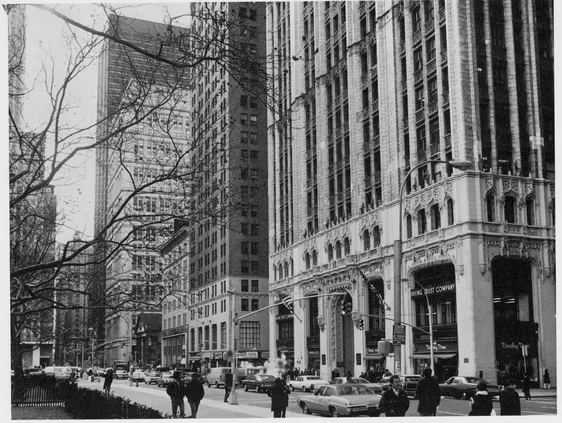
West Side of Broadway, South from Park Place (1974)
The entire west blockfront of Broadway from Park Place to Barclay Street was torn down in 1911 to make way for the world-famous Woolworth Building. When completed in 1913, it was the tallest skyscraper in the world and remained so until 1931. It was designed by Cass Gilbert, already noted for the Customs House at the foot of Broadway. The Woolworth Building is known for its Gothic styling and for its lobby, frequently called the most beautiful in New York. The New York Architectural League awarded its Medal of Honor to Gilbert in 1916 for what it considered one of the country’s finest buildings—which it still is. South beyond the Woolworth Building is the Transportation Building (1927) and the six-story Franklin Building (1914), both built on the site of the Astor House. The portico of St. Paul’s Chapel, the only building in the 1880 photo still standing, is visible on the block from Vesey to Fulton Streets. On the next block south is the 28-story A.T.& T Building (1914-22). Towering at Cortlandt Street stands the all-steel United States Steel Building (1972), one of the many built in this style in New York City during recent years. (12/3/74; 1:55.)
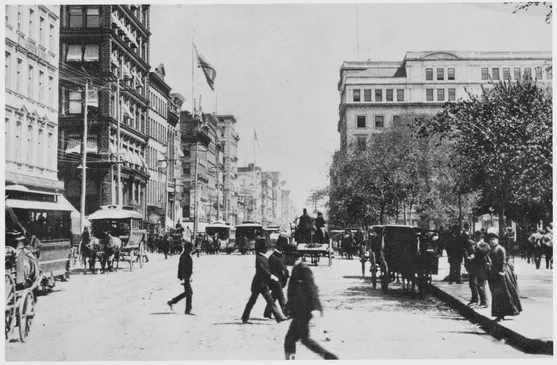
Broadway, North from Murray Street (1887)
The edge of City Hall Park is on the right. Left, on the southwest corner of Warren Street, is No. 259 (Devlin & Co.), where Tiffany & Co. was founded in 1837. The white-marble building (Trench & Snook, architects) seen above the trees of City Hall Park was opened in 1848 as the dry-goods store of A. T. Stewart, who moved to a larger store at Broadway and East 9th Street in 1862. In 1885 two stories were added to the building. Omnibuses are seen sharing Broadway with the newer horsecars, which had only been permitted on lower Broadway, after much litigation, since 1885.
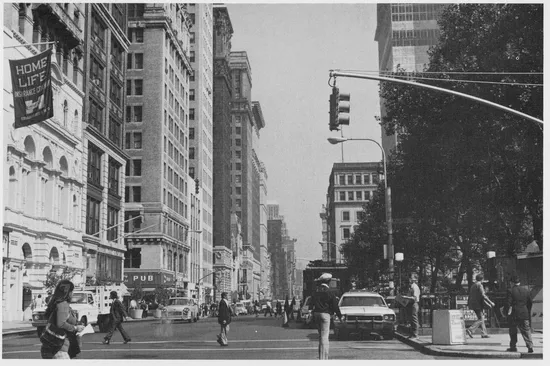
Broadway, North from Murray Street (1974)
Broadway remains a busy thoroughfare, and in this section the nature of its business is the same. The marble building has had a further addition—the top-story corner has been filled out. A few of the older buildings can still be seen on Broadway. On the left, the elaborate lower stories of the Home Life Insurance Building (1893-94) remain without alteration. The latest skyscraper, rising on the right, is anew addition to the Federal Building on Foley Square. (9/30/74; 10:20.)

East Side of Broadway, North of East Houston Street (1875)
The Olympic Theatre, at No. 624 Broadway, between Houston and Bleecker Streets, was opened on November 18, 1856, as Laura Keene’s Varieties Theatre, but was shortly afterwards renamed Laura Keene’s New Theatre. Miss Keene retired as manager of the Olympic in 1863. It was Laura Keene who was appearing in Our American Cousin at Ford’s Theatre the night President Lincoln was assassinated. The Olympic reopened as Mrs. John Wo...
Table of contents
- Title Page
- Copyright Page
- Table of Contents
- PUBLISHER’S NOTE
- NEW YORK THEN AND NOW - 83 MATCHING PHOTOGRAPHIC VIEWS FROM 1864–1938 AND FROM THE 1970s